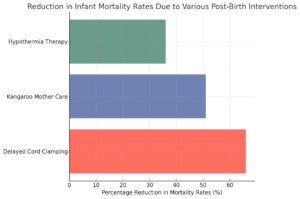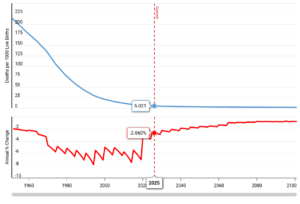Authored by: Humza Rana
Embrace a tactical methodology to lower the rate of infant death; staff education and community-based investigation are crucial. As of now, Saudi Arabia’s infant mortality rate (IMR) stands at 5.1 infant deaths for every 1,000 live births, ranking it sixty-third among 253 nations worldwide. In contrast, advanced G20 nations such as Japan and Italy record the lowest IMRs of 1.6 and 2.2, respectively. The current infant mortality rate for Saudi Arabia in 2025 is 5.021 deaths per 1000 live births, a 2.66% decline from 2024.
In the Middle East, national reform initiatives and transformation strategies have emphasized the importance of advancing healthcare systems to guarantee accessibility, verify cost-effectiveness, enhance life expectancy, and elevate the overall quality of life. A vital measure of a country’s health, societal stability, and economic progress is infant mortality. Presently, Saudi Arabia records an infant mortality rate (IMR) of 5.1 infant fatalities per 1,000 live births, ranking it 63rd out of 253 nations worldwide. In contrast, developed G20 nations such as Japan and Italy boast the lowest IMRs at 1.6 and 2.2, respectively.
Innovative Programs for Infants’ Well-being
Saudi Arabia’s medical system has experienced an impressive evolution in recent years, marked by significant investments aimed at broadening and enhancing the healthcare framework. This progress has enabled the launch of state-of-the-art health initiatives designed to bolster infant well-being.
Prominent actions include the establishment of dedicated neonatal intensive care units in various hospitals, sophisticated screening for congenital abnormalities, and an increased focus on prenatal and postnatal support. These measures seek to identify and address infant health challenges proactively, securing a healthy beginning for every child.
A notable initiative is the rollout of comprehensive health facilities in both urban and rural settings, granting mothers and infants timely access to essential health services. The facilities emphasize maternal education, pediatric healthcare, immunization, and nutritional guidance to foster infant health during the crucial early phases of life.
Although the Kingdom has achieved remarkable advancements in healthcare provision and results, there is still a chance for the nation to further enhance and establish itself as a frontrunner in infant wellness. By executing a thorough array of strategies over the next 15 years, Saudi Arabia could reduce the Infant Mortality Rate (IMR) by 50 percent, potentially preserving 7,500 to 9,000 infant lives. This would position Saudi Arabia among the top 20 nations worldwide regarding IMR, contributing to a more dynamic and resilient society while furthering the Kingdom’s Vision 2030 objectives of elevating health outcomes and boosting life expectancy.
Diminishing the infant mortality rate (IMR) and its Economic Impact
Diminishing the infant mortality rate (IMR) would also facilitate the growth of Saudi Arabia’s economy by expanding its labor force and enhancing productivity. The economic loss attributed to each death is estimated to exceed SAR 9 million, signifying considerable long-term economic advantages. Furthermore, applying evidence-based healthcare strategies to mitigate preterm births could lead to improved health results while simultaneously reducing healthcare expenditures. This is particularly crucial, as the medical costs for preterm low birth weight newborns can be 30 to 100 times greater than those for full-term babies.
Efforts to lower the Infant Mortality Rate (IMR) demand a comprehensive, multifaceted approach that goes beyond simple healthcare provisions. A holistic strategy involves a range of interconnected actions that address the root causes of infant deaths and create a supportive environment for maternal and child health. One of the core elements is the investment in healthcare systems, ensuring they are equipped with adequate infrastructure, medical equipment, and resources to provide high-quality care. This includes improving prenatal, antenatal, and postnatal care services, making them accessible to all regions, particularly underserved communities.
Another critical aspect of the strategy is training and capacity building for the healthcare workforce. A highly skilled and well-trained medical staff is essential for delivering effective care to mothers and infants. This involves continuous education, certification, and providing exposure to the latest medical advancements and treatment protocols to keep healthcare professionals up to date with best practices.
Regulatory measures, supported by scientific research and evidence, must form the backbone of the healthcare policy framework. This includes the establishment of evidence-based guidelines for infant care, immunization, nutrition, and disease prevention, all aimed at reducing risks that contribute to infant mortality. Moreover, regulations ensuring the safety of the healthcare environment, such as hygiene standards and quality control of medical procedures, are also critical.
Localized research and innovation will help tailor interventions that are culturally appropriate and specific to the health challenges within a given community. The unique needs of different regions must be recognized to create customized healthcare solutions, particularly for rural or isolated populations. This may include improving access to healthcare facilities, establishing mobile health units, or fostering community-level health initiatives.
The focus on clinical interventions grounded in evidence ensures that medical care follows proven, scientifically validated methods. Whether through advanced treatments for prematurity, infection prevention, or maternal care, interventions must be rooted in current research to maximize their effectiveness in reducing IMR.
Real-time monitoring and evaluation of these healthcare strategies are essential for assessing progress, identifying barriers, and making timely adjustments. Regular collection of data on infant deaths, health outcomes, and service utilization allows healthcare policymakers to make data-driven decisions and address emerging challenges promptly. These systems must be robust and flexible, capable of adapting to changing conditions, ensuring that the healthcare response remains efficient and responsive.
Four Effective Strategies
Several proven strategies have demonstrated significant results:
- Antenatal screenings: Engaging in antenatal care, which includes regular assessments conducted by qualified healthcare professionals, enhances the chances of early detection of potential issues, allowing appropriate medical action to be taken promptly. Maternal attendance to these screenings leads to a 34% reduction in neonatal mortality.
- Maternal supplementation: Studies indicate that administering iron and folic acid during pregnancy can lower the risk of infant mortality by 34% during the initial 11 months of life. This straightforward yet powerful practice guarantees that both mother and infant receive vital nutrients for a robust beginning.
- Care immediately after birth: Postponing cord clamping by a mere two minutes has been shown to decrease the risk of death prior to discharge for premature infants by 66%. Encouraging skin-to-skin interaction, commonly referred to as kangaroo mother care, has been linked to a 51% decline in mortality rates among low birth weight newborns.
- Neonatal hypothermia therapy: Lowering the body temperature of newborns suffering from hypoxic ischemic encephalopathy (brain damage due to lack of oxygen) has demonstrated a 36% reduction in infant death rates.

Postnatal Home Visits
Consistent oversight and assistance during the crucial early days of life are essential for both mothers and infants. Receiving the first postnatal care visit within 48 hours of birth correlates with a 64% reduction in mortality compared to those who did not have a visit. Home visits encourage breastfeeding and ensure adequate infant nutrition, thereby mitigating the risks of postpartum complications.
Saudi Vision 2030 and Infant Mortality Rate (IMR) Reduction
Saudi Vision 2030 aspires to enhance life longevity, upgrade healthcare services, accomplish enduring population health objectives, and boost the Kingdom’s standing in global wellness rankings. A specific emphasis on lowering IMR underpins all four. The research backing the suggested clinical interventions is robust, and the potential for preserving lives is vast. By prioritizing these actions and ensuring their implementation, Saudi Arabia can achieve considerable progress toward a healthier, more flourishing future for all its citizens.
These strategies not only improve infant survival rates but also contribute to creating a healthier society overall, aligned with the broader goals of Vision 2030. By investing in targeted interventions and systemic healthcare improvements, Saudi Arabia has the opportunity to drastically reduce IMR and become a leader in infant wellness on the global stage.

Cutting-Edge Technology and Research Innovations
Saudi Arabia is leveraging cutting-edge technologies and medical studies to improve care for mothers and their babies. The nation’s research landscape has been enhanced with funding for healthcare-related investigations aimed at child wellness, neonatal critical care, and pediatric conditions. Collaborations between Saudi institutions and international research bodies are leading to significant advancements in the treatment and prevention of infant health issues. By adopting artificial intelligence, data analysis, and remote health surveillance, the Kingdom’s healthcare framework is becoming increasingly adept at early interventions, providing tailored care for newborns, and further aiding in the reduction of mortality rates.
Conclusion:
Saudi Arabia is making significant strides in improving infant well-being by implementing innovative healthcare programs. These initiatives focus on enhancing healthcare access, providing better nutrition, and ensuring timely medical interventions. The country’s investment in advanced healthcare solutions demonstrates a strong commitment to reducing infant mortality rates and fostering healthier future generations. This proactive approach highlights the nation’s dedication to strengthening its healthcare infrastructure, particularly for the most vulnerable members of society—the infants.
Q/A
- What is IMR?
A) The Infant Mortality Rate (IMR) is a statistic used to measure the number of infants who die before reaching their first birthday, expressed per 1,000 live births in a given year. It serves as a key indicator of the overall health and quality of a country’s healthcare system, especially for maternal and child health. A lower IMR generally reflects better access to healthcare, better nutrition, and overall improvements in living conditions, whereas a higher IMR can indicate challenges in healthcare access, sanitation, nutrition, and other social determinants of health.
Sources
a. Reducing Infant Mortality in KSA Strategy&
b. Macro trends – Saudi Arabia Infant Mortality Rate
